Both computerized and vintage sewing machines need regular care and cleaning. You wouldn’t expect your car to keep running without the occasional tune-up, and neither will even a reliable sewing machine like a Viking! The good news is, you can often complete basic Viking sewing machine repairs yourself.
Troubleshooting and repairing a Viking sewing machine involves taking apart and cleaning it. A sewing machine may also need adjustments in tension, feed, or bobbin position. Replacing the needle, rethreading the needle path, and checking the feed dogs will also fix several common issues.
In this article, you’ll learn how to troubleshoot the most common sewing machine issues. You will find a step-by-step guide for tricky issues like adjusting tension. Finally, you’ll also get tips for when you need to step back and hand your machine over to a professional for help.
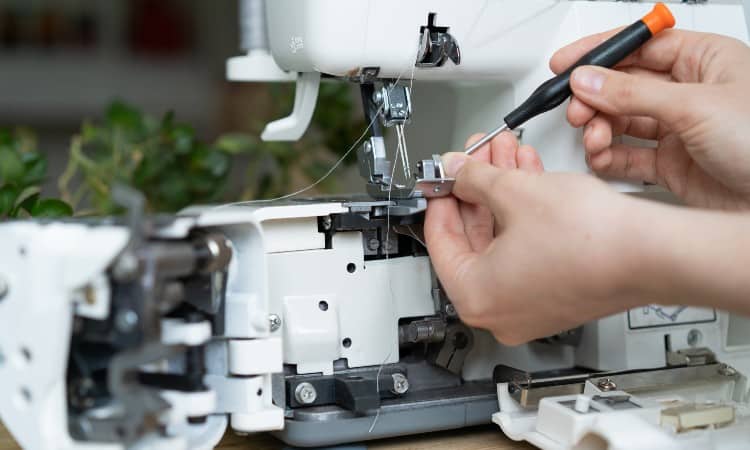
Is It Worth Repairing a Sewing Machine?
When something goes wrong with your sewing machine, you should almost always consider repairing it. You can learn to make many repairs yourself, and even going to a professional will cost a lot less than buying a new sewing machine!
Plus, older sewing machines can last for decades, given the proper care. New, computerized machines can last anywhere from five to twenty-five years, depending on their quality of construction.
Of course, learning how to provide basic maintenance for your machine will help prevent many big repairs down the road. Just like taking your car in for an oil change or tire rotation will help keep it running for a lot longer!
Most of the time, you can easily fix issues like a broken needle, tangled-up tension, loose stitching, or jammed bobbin.
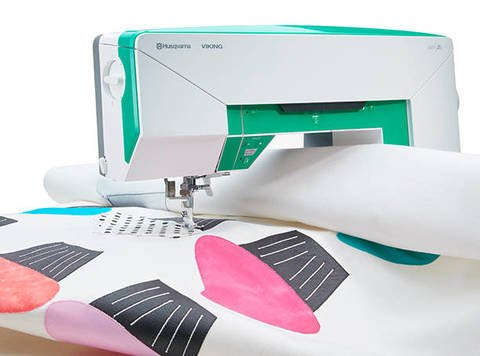 Computer issues like a touchscreen not responding might require professional care. Depending on your skill level, you may feel confident disassembling mechanisms inside the machine, or you may prefer to take that level of repair to a technician as well.
Computer issues like a touchscreen not responding might require professional care. Depending on your skill level, you may feel confident disassembling mechanisms inside the machine, or you may prefer to take that level of repair to a technician as well.
So, how much do you have to know to become a DIY sewing machine expert? Not that much! It helps to understand the basics of how a sewing machine functions.
You will also want to have your sewing machine manual on hand since that handy document will explain many key maintenance and cleaning tasks. YouTube tutorials also offer a helpful visual guide for many basic repairs. Finally, this article will walk you through the most common fixes you can use yourself to keep your Husqvarna Viking machine running.
Common Husqvarna Viking Sewing Machine Problems
Even really reliable sewing machines like Husqvarna Viking models run into problems on occasion. Depending on your sewing experience, you may struggle more with some of these than others. Regardless, here are the top eight issues you may run into while using your Husqvarna Viking sewing machine.
- Skipped or loose stitches: Caused by bent, broken, or dull needle or incorrect tension. Change the needle and loosen the top tension to fix this issue.
- The needle snaps: Often caused by sewing over a pin, button, or zipper. Using the incorrect presser foot could also cause a needle to break. Finally, check to make sure the needle and needle plate align correctly to avoid breaking any more needles!
- Handwheel and needle-bar stuck: Bobbin tension gone wrong can jam everything up. Try turning off and unplugging the machine, removing the bobbin casing and any tangled thread, and rethreading the machine. Then turn it back on and see if the wheel will turn!
- Tangled thread beneath fabric: Mismatched tension can cause “thread nests” to bunch up on the underside of your fabric. Rethread the machine. If this does not fix the issue, try setting the top tension one level higher.
- Sewing machine won’t run: This usually indicates a power supply issue. Turn everything off and unplug both the power cable and the foot pedal cord. Then plug the cords back in and restart the machine.
- Broken needle thread: This one can have many causes, but the most common culprit is thread tension. As always, start by rethreading and then adjust the top tension to a lower setting. The wrong size of the needle, a dirty bobbin casing, and poor quality thread can also make thread break while sewing.
- Puckered stitches: This happens in the reverse of the more common skipped stitches. It usually means the top tension requires adjustment, though a too-big needle can also cause puckering in the fabric.
- Touchscreen won’t respond: This could require calibrating in the device menu under Settings, or it could require professional servicing.
Husqvarna Viking Sewing Machine Troubleshooting
To troubleshoot your Husqvarna Viking machine most effectively, you should know how to perform a basic cleaning, how to thread your machine, whether or not to apply oil, and what your warranty covers.
But first, here’s a quick overview of what to expect from your Viking model.
Husqvarna Viking has a centuries-long history as a manufacturing company based in Sweden. Husqvarna began selling sewing machines in the late 1800s, and the company still designs its new models in Sweden today.
The brand has a stellar reputation for delivering reliable, cutting-edge sewing technology.
That said, SVP Worldwide bought out Viking in the 2000s. Since then, the manufacturing of the machines has taken place in China.
Viking models made before 1900 are considered antique and may have collectible value. Models made between 1900 and 1970 usually get termed “vintage.” Some of these do have slight collectible value, but mostly they are valued because they contain solid metal parts and can keep running for decades!
As you begin troubleshooting your machine, start by finding out what year it was made. This will help determine the kinds of things you can fix.
Basic Cleaning
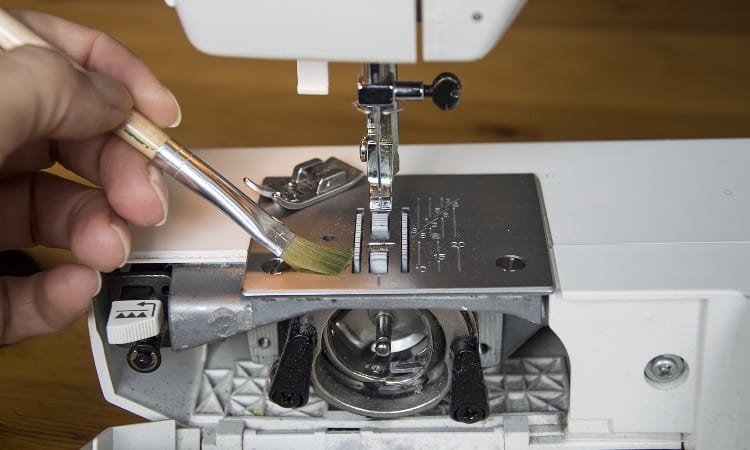
All sewing machines, old and new, fancy or cheap, require regular cleaning! Unless you haven’t serviced your machine in a long time, you can typically perform these tasks just once a month to keep everything in tip-top shape.
- Start by unplugging your machine: you may roll your eyes, but it’s not safe to clean or disassemble any electrical appliance unless you unplug it first.
- Get rid of the lint: you know how dryers have a lint trap you have to pull out and regularly clean when you do laundry? Well, sewing machines collect a buildup of fabric fibers as well! Clearing out the lint around the bobbin casing and thread path will prevent your machine from getting clogged up over time.
- Get rid of the lint, advanced version: you should also unscrew the needle plate and get in there with a tiny paintbrush to make sure no lint lingers! You shouldn’t need to get this detailed more than once a month unless you sew all day, every day!
- Oil the machine (sometimes): older machines often require a few drops of sewing machine oil in key places regularly. That said, most new machines should never, ever be oiled! Check your manual to find out if you need oil or not.
- Wipe down the body: modern machines typically have a plastic casing that you can wipe down with a soft cloth. You should never use a wet cloth on metal or cast-iron machines, as this could cause rusting.
- Replace the needle: you should replace the needle at the start of every new project, taking care to match the needle size and design to the project’s needs. If you feel like that’s too much, at least replace the needle at your monthly cleaning session!
- Finally, do a test run on a scrap of fabric to make sure everything works!
Does My Viking Sewing Machine Need Oil?
Most newer Viking sewing machines do not require oil, while vintage models typically do need monthly oiling.
Unless the sewing machine manual says otherwise, any machine made after 1972 should not need oiling. You don’t want to add oil, as this will cause a mess and possibly damage the inner workings of your machine!
Machines made pre-1972 very likely will need oil. You can determine this in two ways: First, read the manual. This will spell out if you need to apply oil and where to do so. Second, rub the needle bar and look at your fingers.
Did your skin come away feeling oily? In this case, the machine doesn’t require oil at this time. If your fingers do not feel greasy, you need to apply oil!
With the caveat that you should always follow the directions laid out in your user manual, these steps will talk you through the most common way to oil a Viking machine:
- Unplug the machine and set it on a flat workspace.
- Remove the bobbin, bobbin case, presser foot, and needle plate. You may need a small screwdriver for some of these parts.
- Give each part a quick dusting with a clean brush and set aside on a clean cloth.
- Remove the race (the area that holds the bobbin case). As a pro tip, snap a pic with your smartphone before taking this out, so you can easily put it back correctly!
- Use your brush to get out any lint that could soak up your oil in the race area and beneath the feed dogs.
- Turn the handwheel and put a tiny drop of oil on any metal part that moves. Try to avoid any plastic parts or gears.
- Smudge a tiny bit of oil around the race area.
- Insert the race and needle plate, but leave the needle out. Plug in the machine and run it for a few seconds to make sure the oil moves around the metal parts.
- Finally, assemble the bobbin casing, bobbin, presser foot, and needle. Use a scrap of fabric to sew a test run for a moment.
How to Thread a Viking Sewing Machine
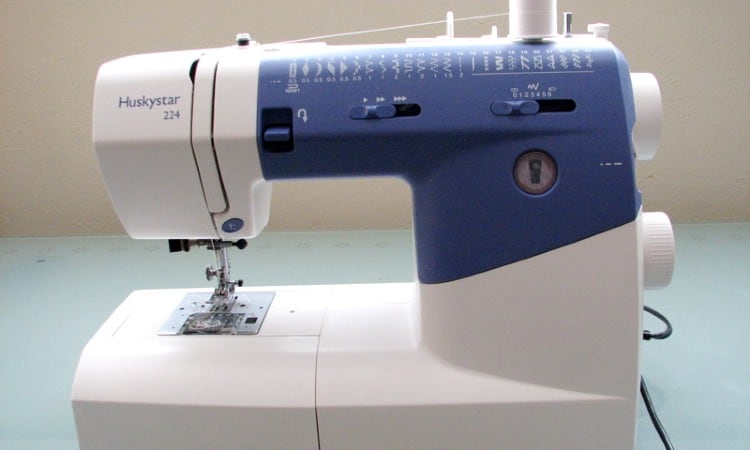
Source: Lenore Edman
Knowing how to thread your Viking machine is key to keeping it running smoothly. Nine times out of ten sewing machine issues just need a quick rethreading to get everything back on track!
Here’s the catch, though: every model looks a bit different. Vintage models, in particular, may have a unique thread path, while brand-new models may have easy, color-coded thread paths to help guide your way!
Your best bet to make sure you thread your machine right is to read the owner’s manual and follow the directions laid out there.
That said, the basics of threading look pretty similar for most machines.
- Slide your spool of thread onto the spool pin and secure it. Most machines come with a plastic spool cap that keeps the spool from flying away into the air as you sew!
- Pull about ten inches of thread free.
- Wrap the loose end of the thread around the thread guides and then through the tension discs. Yes, this is the tricky part, but don’t panic! Most machines have numbers printed next to each of these parts to tell you where and how to wrap the thread.
- As a pro tip, make sure the presser foot is raised to keep the tension discs separated as you do this.
- Follow the arrows to slide the thread down to the needle.
- Place the thread in the final thread guide (usually a small metal hook) right in front of the needle.
- Use an automatic needle threader or thread the needle by hand.
If you learn better visually, try typing the exact model number of your Viking machine into Youtube. You will almost certainly find handy video tutorials that will show you how to thread your machine.
Warranty
If you bought your machine new, it typically comes with a warranty. This guarantees help from trained Viking technicians if you need it.
However, if you take apart or mess with the machine yourself, you could void the warranty! This makes sense: Viking has no way to know if their machine caused the problem or if you damaged something while poking around inside it.
Because of that, you should read your warranty before doing anything more complicated than a basic cleaning for your machine.
If you bought a used machine, you don’t need to worry about this!
Viking Sewing Machine Repair
As you consider repairing your Viking sewing machine, you will need to know what common errors to expect. You may also need to know where to look for replacement parts. Perhaps most importantly, you will need to know when to throw in the towel and take your machine to a technician for the repair!
How Do You Service a Viking Sewing Machine?
To service your own Viking sewing machine, you should know how to perform basic cleaning and how to replace frequently worn-out parts like needles.
To learn how to clean your machine, refer to your user’s manual, or check out the “Basic Cleaning” section earlier in this article!
You will also want to get comfortable with a tiny screwdriver that will allow you to remove and replace the needle, remove the needle plate, and even adjust the bobbin casing as necessary.
Usually, you will get a small screwdriver and several other cleaning tools when you purchase a machine. Otherwise, try a variety of small flat-head screwdrivers to find one that fits your machine.
Since you need to replace your needle so frequently, check out this quick guide for reference:
- Use your small screwdriver to loosen the needle set screw. You don’t need to pull it out all the way because the needle will drop out as you loosen the screw.
- Gently slide the needle down out of the needle bar. If you haven’t done this often, note which side of the needle has a rounded and flat side to correctly insert the replacement needle.
- Insert the replacement needle butt into the needle bar until you can’t gently-but-firmly push it in any farther.
- Tighten the needle set screw again.
Finding Parts
If you discover a damaged part inside your machine, you will need to find a replacement. You can go about this in multiple different ways.
If you have a newer machine still under warranty, you should contact the company directly. They will almost certainly provide parts and repairs for free. You will need to either pay for shipping or drive to a certified technician, though.
If you have a new-ish machine not under warranty, you can probably find replacement parts through a certified Viking store or the company’s website. You will then need to decide if you want to install the part or if you want to pay a technician for the repair.
Finally, if you have an older machine, you’re going to have to dig a bit deeper. Husqvarna does not provide a lot of support for older machines. It can prove challenging to track down information or parts for these vintage models.
Your best bet is to check eBay, Etsy, or Amazon for vintage Viking parts.
Some trained technicians will work on vintage Vikings, but don’t count on the certified Viking dealers and shops for this service! Many of their technicians no longer receive training on older models.
Professional Help
This leads to the question of when you should leave repairs to the professionals. Honestly, this depends on your comfort level.
If you feel confident in connecting wiring, go for it! Most of the time, though, electrical or computer issues get pretty complicated. It’s probably a good idea to leave these to trained technicians.
Touchscreen issues on new Viking models are a perfect example. You can try turning the sewing machine on and off and going into the menu to reset your settings, but if that fails, you probably don’t want to mess with anything further!
Also, if you tried the most common fixes and your machine still won’t run correctly, you might want to take it into the shop. For example, suppose your needle breaks repeatedly as you sew. If you already tried adjusting the needle plate, something could have gone wrong in a much more complicated way, perhaps with your feed dogs.
Speaking of which, feed dogs can wear out over time. While you can certainly replace this mechanism yourself, it requires precision and skill that may best be left to the technicians.
The bottom line is that you should attempt any repair you think you can handle. If you feel uneasy or just don’t have the time to learn how to fix something, consider finding a nearby Viking repair technician.
How Do I Fix the Tension On My Husqvarna Sewing Machine?
Learning how to adjust the tension on your Viking machine will help you prevent many common sewing issues like skipped stitches or thread nests! One of the most often-asked questions regarding almost all sewing machines is, “how do I adjust the tension?”
Thread tension works by putting a certain amount of force, or strength, on the threads that come from the thread spool and the bobbin. The tension mechanisms work separately. Usually, the top tension will need adjusting very often, while the bobbin tension rarely requires adjustment.
Pretty much any kind of messy stitching that does not show flat, even stitches on both sides of the fabric, means that you need to make a tension adjustment. Different kinds of fabric often need different levels of tension as well.
The only exception to this rule is having a fancy, high-end sewing machine that automatically adjusts tension for you!
On some new Viking models, you can use the touch screen to adjust tension settings. On other models, you will find a dial you can spin to set the tension.
Setting the tension to a higher number will increase the resistance against the thread, giving you greater tension in the stitches as you sew. Likewise, lower numbers will indicate less tension as you sew.
You can easily test the tension by using contrasting colors of thread in your bobbin and thread spool. Then, check to see if either of the threads puckers, skips, stitches, or knots up as you sew!
Foot Pedal Not Working
If you press down on the foot pedal and nothing happens, you should first check the connection point where the foot pedal plugs into the machine. If unplugging and replugging doesn’t work, look for a loose wire where the cable connects to the foot pedal.
If you feel brave, open up the plastic casing of the foot pedal and see if you can spot any loose or broken wires. A connection may have jiggled loose inside.
If this fails, you probably need a new foot pedal. Fortunately, you can typically get these pretty cheaply! You will want to make sure you buy the correct pedal designed for your machine, though.
Feed Dogs Stuck Down Position
Stuck feed dogs will bring your sewing to a screeching halt.
The feed dogs look like tiny teeth in the middle of the needle plate. They run like little treadmills to keep the fabric moving beneath the needle as you sew. Of course, this means that things go wrong when your feed dogs get stuck!
Most often, this happens when lint or thread jams up the feed dogs, preventing them from moving. If you clean your machine regularly, this shouldn’t happen!
Incorrect threading could also cause the feed dogs to jam and refuse to move, so always try rethreading your machine just in case.
What to Do If Your Viking Sewing Machine Jams Up
If your sewing machine jams up and you can’t turn the handwheel at all, you may need to either rethread the machine or disassemble some components before getting it running again.
First, try removing the fabric from under the presser foot. This may require scissors! Then rethread everything. Rethreading fixes jams more often than you might think!
If that didn’t work, follow these steps:
- Check the power cord and make sure it’s plugged into your sewing machine and the wall outlet correctly.
- Try turning the machine on and off.
- Check the foot pedal for loose wires and plug it firmly into the machine.
- Check the bobbin casing and make sure no loose thread has tangled it up, preventing the bobbin from turning.
- Clean the hook and oil it if your manual indicates it is safe to do so.
- Then reassemble the bobbin and bobbin casing, and turn the handwheel to see if it moves!
Husqvarna Viking Dealers Near Me
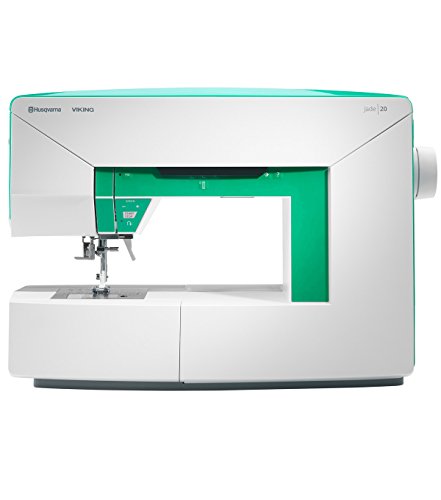 If you’re looking to buy a Viking machine or in need of a certified Viking technician, you will want to find a dealer or shop near you. You can typically locate a certified online dealer or physical shop by Googling. You can also go to Husqvarna’s website to locate an official store near you.
If you’re looking to buy a Viking machine or in need of a certified Viking technician, you will want to find a dealer or shop near you. You can typically locate a certified online dealer or physical shop by Googling. You can also go to Husqvarna’s website to locate an official store near you.
Of course, you can take your machine to a local mom-and-pop repair shop and hope for the best. But if your machine is still under warranty or if you want 100% certainty of success, make sure your technician is certified to work on Viking machines!
Sewing machine repair requires lots of training and certification, so you should expect to pay a pretty hefty fee for most services. A basic tune-up will typically cost around $100, for example. Some technicians charge by the hour plus parts, like car mechanics. Others may charge by the type of repair.
You should bring your machine, the power cord, the foot pedal, and the basic zigzag foot with you when you go to a repair shop.
Conclusion
Even really great sewing machines like Husqvarna Viking models will occasionally need repairs or basic troubleshooting. You can easily teach yourself how to replace needles, adjust tension, and remedy jams. Of course, keeping up with a monthly cleaning schedule will also help your machine run like a dream!
Knowing how to find a reputable, certified Viking technician can rescue your sewing machine when all else fails.
What kinds of sewing machine issues have you tried to troubleshoot? How did you fix the problem? Leave a comment below to let us know!